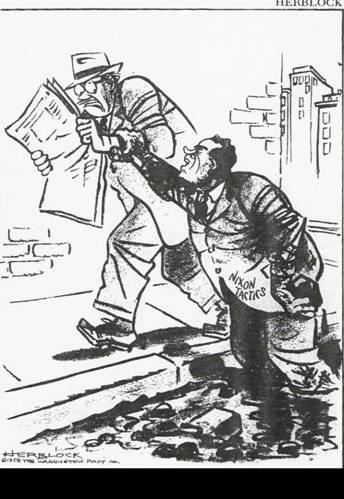What Does the Vice President Actually Do?
Download this lesson plan as a Word document
 This lesson is envisioned as a two-day lesson or a one 90-minute block teaching session that include the HNN backgrounder, articles, political cartoons, and video. There is also an optional day three “debate session” to help student’s process and synthesize the material.
This lesson is envisioned as a two-day lesson or a one 90-minute block teaching session that include the HNN backgrounder, articles, political cartoons, and video. There is also an optional day three “debate session” to help student’s process and synthesize the material.
Common Core Standards Correlation:
Reading Standards for Literacy in History/Social Studies Grades 9-12: standards 1-4, and 6-9
Writing Standards for Literacy in History/Social Studies Grades 9-12: standards 1-9
Readings/Resources:
Objectives:
Day One
A. Introduction (Bell Ringer):
I) Have students view video and then take notes on what the enumerated tasks of the vice president.
Role and History of Vice Presidential Candidates [VIDEO, 10 minutes]
II) Why did the founding fathers create the 12th Amendment and change the election of the vice-president?
Read Top Ten Contested Elections: The Revolution of 1800
1) What was the crisis that surrounded the 1800 presidential election?
2) What are the advantages and disadvantages of electing the President and Vice-President together?
3) How does a joint election lead to the development of more a more entrenched two-party system?
Essential Question: How important is the vice-president to running the government?
B. General Discussion
Have students identify the vice president for each of the following presidents, and explain how each president treated them and why:
1) Franklin Delano Roosevelt
2) Dwight D. Eisenhower
Based on the political cartoon below, how might Ike feel about Nixon as vice president while he campaigned during the mid-year elections?

3) John F. Kennedy
4) Richard Nixon
5) Jimmy Carter
6) George W. Bush
What does the political cartoon below tell us about how Cheney viewed his role as vice president?

Day Two
C. Group Work: Article Analysis
Students can actively read the article for homework, and then work in groups to cooperatively answer the questions
Joel K. Goldstein: How the Vice President Can Serve as the President's Most Unbiased Adviser
Group Work: have students answer the following questions and then share out their responses:
1) What role did Walter Mondale, vice president to Jimmy Carter, propose for the office of the vice presidency?
2) How would the vice president help with presidential decision-making?
3) Why is debate important to decision-making, and how does the vice president help the debate on public policies?
4) Why must a vice president be a trustworthy advisor, versus a “pawn” to cater to partisan groups?
5) How does our current vice president help our president?
Summary of Essential Question: How important is the vice president to running the government?
Day Three (optional)
D. Summary Debate: Is the vice president an asset or liability to the president of the United States?
1) Have students create a T-chart that lists the assets and liabilities of a vice president’s actions on the president’s position
2) Have students research the role of our current vice president on national politics. Each student should bring in three policies or developments the current vice president worked on, and explain how it impacts the president’s policy positions
3) Students should evaluate the importance of the vice president’s actions and how they relate to helping or hindering the president’s position with the American people.
Enrichment:
Have students create a political cartoon that illustrates their assessment of the current vice president’s impact on the president’s policies.
Have students construct their own video interpretation of the role of the vice president throughout history.